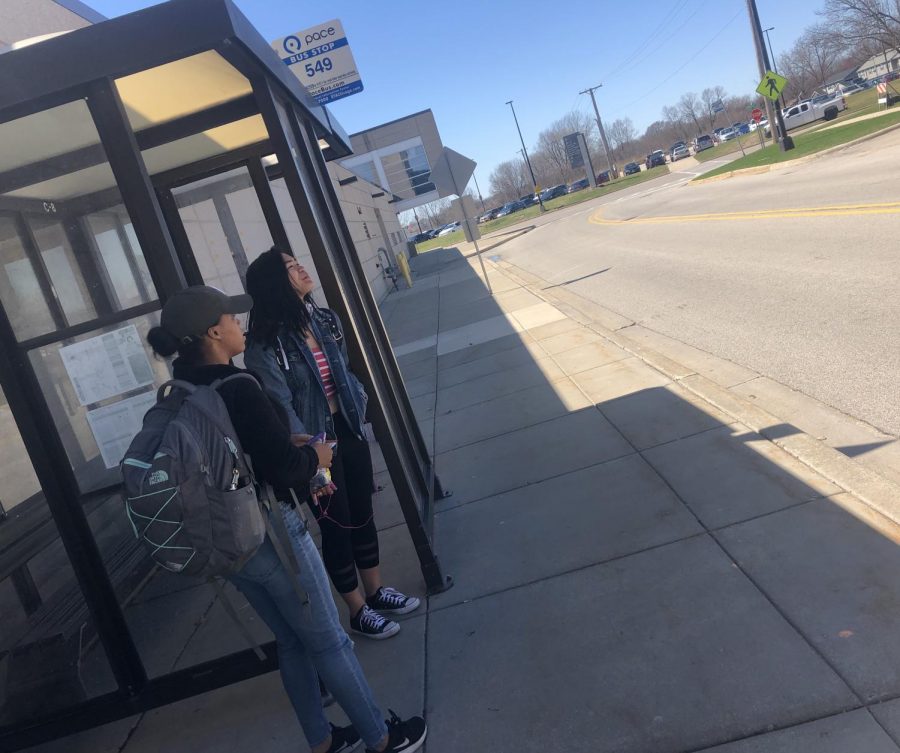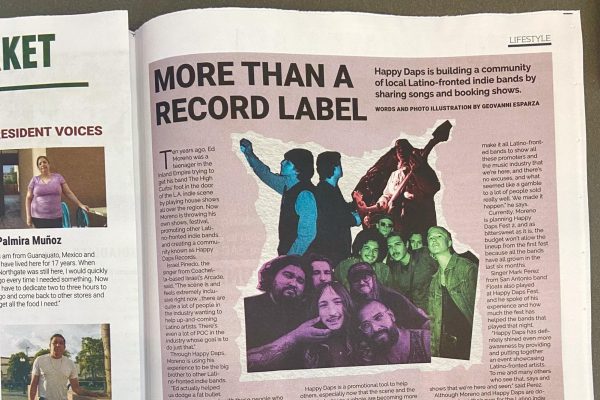ECC students traveling from Pace and Ubers
Naja May-Pearson waiting after school for the 2:23 p.m. Pace bus.
Getting where you need to go without having your own car can be a struggle in the beginning, especially when it’s something you’re not completely used to. But what about the students that don’t have access to their own car or even live close by? Those students rely on public transportation to get them where they need to go, but since they take public transportation, they might face different problems.
Naja May-Pearson, a student at ECC, knows what it’s like to have her schedule set around public transportation. Since she relies on the Pace bus to get her to school and back home, when setting up her class schedule, she can’t have classes after five, because then she would miss the last bus that transfers to the Streamwood bus that allows her to arrive safely home.
“Sometimes I do have to work around the Pace schedule,” May-Pearson said. “I can’t take classes too early or too late.”
For May-Pearson, if she were to be running late to class, there would be no point in her attempting to take the Pace bus because she would have to wait an hour or so for another bus to come. So, instead, she would just call an Uber or Lyft to take her to school.
“It’s expensive going to school and ordering a ride,” May-Pearson said. “The starting price from my house to ECC is already $17, so if I were to be late the whole week, that’s $100 spent on Uber to get to school and go home.”
May-Pearson isn’t the only student that has experienced the frustrations of the Pace schedule. Raziel Martin, another ECC student, commutes all the way from the city and had to learn to get used to how the Pace schedule operates since it’s so much different from the CTA.
The CTA runs every day and frequently compared to the Pace bus, which only runs on weekdays and at certain times. If you miss your CTA train, you won’t have to wait too long for another one to pass through, whereas you could be waiting for another hour or so for another Pace bus.
Martin’s school schedule largely revolves around the Pace bus schedule, so he also can’t take classes too late or he would miss the last bus to get home.
“I learned from last semester that if I don’t have my class schedule working with the pace bus, I’ll be rushing to make sure I get to the bus stop after my class ends,” Martin said. “If I have questions after class, I can’t ask them in person. I [know that I] have to send them in emails and go to office hours early.”
Staying late isn’t an option for Martin unless he’s carpooling with someone. If he happens to have a friend that’s going the same way as he is, then he’s saving some money by getting a ride from them and is then able to stay at school a bit later than he usually would.
“Last semester, I got rides home from friends, which was nice because I didn’t have to stress about missing a bus or rushing to get home,” Martin said.
School isn’t the only thing Martin has to make compatible with the Pace bus hours. Going from home to school and to work, and then back home, and still finding a running bus that will bring you back home isn’t easy.
“Most of the time, to get to work, I have to spend money on an Uber if I’m leaving from school to go to work because if I wait for the pace bus, then I’d be late to work, and probably won’t have a job, since it’s my responsibility to get there,” Martin said. “And if I’m running late, I have to Uber to get to work. I would probably spend around $115 on Uber a week if I’m running late to both school and work.”
For ECC student Nadya Quezada, taking the Pace bus is something she relies heavily on in order to get to work because she gets dropped off at school in the mornings. When it comes time for her shift, she leaves school early to catch the bus.
“There are times I’ll be at work 30 minutes early before I start because the Pace bus I catch drops me off at my stop early, and if I were to miss that bus, I would be late for work,” Quezada said. “So, for those times I’m at work early, I either ask to clock in early or work on some homework until it’s time to start.”
Though Quezada gets dropped off at school, there are some days that she’s not able to get a ride to class and she must order an Uber to take her to school.
“Since I live close to ECC, I don’t spend as much money as other people do,” Quezada said. “I probably spend $15 on an Uber to get to school, and even though that might not seem like a little amount, I have friends that spend more than that.”
Carpooling with a family friend is something that Quezada does after work to get home if they happen to be working a shift together.
“Carpooling after work happens sometimes, but when it doesn’t, I either Uber home or my mom comes and gets me if she can,” Quezada said. “It’s nice to get to carpool because it saves money, and since the Pace bus isn’t around often to take people where they need to go, it’s a great, safe resort.”

I’m studying broadcast journalism. This is my first year at ECC and I decided to join The Observer because I wanted to get better at writing and explore...








